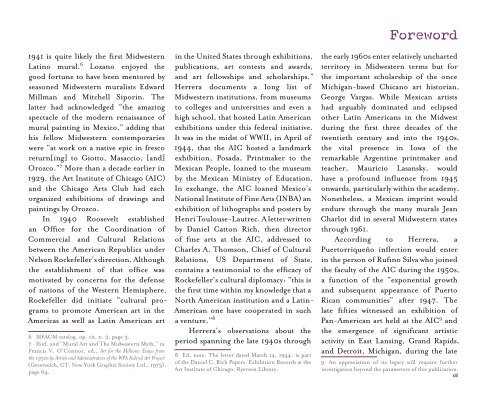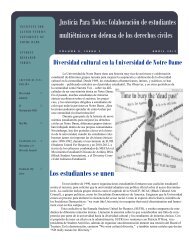Olga U. Herrera - The Institute for Latino Studies - University of Notre ...
Olga U. Herrera - The Institute for Latino Studies - University of Notre ...
Olga U. Herrera - The Institute for Latino Studies - University of Notre ...
Create successful ePaper yourself
Turn your PDF publications into a flip-book with our unique Google optimized e-Paper software.
1941 is quite likely the first Midwestern<br />
<strong>Latino</strong> mural. 6 Lozano enjoyed the<br />
good <strong>for</strong>tune to have been mentored by<br />
seasoned Midwestern muralists Edward<br />
Millman and Mitchell Siporin. <strong>The</strong><br />
latter had acknowledged “the amazing<br />
spectacle <strong>of</strong> the modern renaissance <strong>of</strong><br />
mural painting in Mexico,” adding that<br />
his fellow Midwestern contemporaries<br />
were “at work on a native epic in fresco<br />
return[ing] to Giotto, Masaccio, [and]<br />
Orozco.” 7 More than a decade earlier in<br />
1929, the Art <strong>Institute</strong> <strong>of</strong> Chicago (AIC)<br />
and the Chicago Arts Club had each<br />
organized exhibitions <strong>of</strong> drawings and<br />
paintings by Orozco.<br />
In 1940 Roosevelt established<br />
an Office <strong>for</strong> the Coordination <strong>of</strong><br />
Commercial and Cultural Relations<br />
between the American Republics under<br />
Nelson Rockefeller’s direction. Although<br />
the establishment <strong>of</strong> that <strong>of</strong>fice was<br />
motivated by concerns <strong>for</strong> the defense<br />
<strong>of</strong> nations <strong>of</strong> the Western Hemisphere,<br />
Rockefeller did initiate “cultural programs<br />
to promote American art in the<br />
Americas as well as Latin American art<br />
6 MFACM catalog, op. cit. n. 2, page 3.<br />
7 Ibid. and “Mural Art and <strong>The</strong> Midwestern Myth,” in<br />
Francis V. O’Connor, ed., Art <strong>for</strong> the Millions: Essays from<br />
the 1930s by Artists and Administrators <strong>of</strong> the WPA Federal Art Project<br />
(Greenwich, CT: New York Graphic Society Ltd., 1973),<br />
page 64.<br />
in the United States through exhibitions,<br />
publications, art contests and awards,<br />
and art fellowships and scholarships.”<br />
<strong>Herrera</strong> documents a long list <strong>of</strong><br />
Midwestern institutions, from museums<br />
to colleges and universities and even a<br />
high school, that hosted Latin American<br />
exhibitions under this federal initiative.<br />
It was in the midst <strong>of</strong> WWII, in April <strong>of</strong><br />
1944, that the AIC hosted a landmark<br />
exhibition, Posada, Printmaker to the<br />
Mexican People, loaned to the museum<br />
by the Mexican Ministry <strong>of</strong> Education.<br />
In exchange, the AIC loaned Mexico’s<br />
National <strong>Institute</strong> <strong>of</strong> Fine Arts (INBA) an<br />
exhibition <strong>of</strong> lithographs and posters by<br />
Henri Toulouse-Lautrec. A letter written<br />
by Daniel Catton Rich, then director<br />
<strong>of</strong> fine arts at the AIC, addressed to<br />
Charles A. Thomson, Chief <strong>of</strong> Cultural<br />
Relations, US Department <strong>of</strong> State,<br />
contains a testimonial to the efficacy <strong>of</strong><br />
Rockefeller’s cultural diplomacy: “this is<br />
the first time within my knowledge that a<br />
North American institution and a Latin-<br />
American one have cooperated in such<br />
a venture.” 8<br />
<strong>Herrera</strong>’s observations about the<br />
period spanning the late 1940s through<br />
8 Ed. note: <strong>The</strong> letter dated March 14, 1944, is part<br />
<strong>of</strong> the Daniel C. Rich Papers, Exhibition Records at the<br />
Art <strong>Institute</strong> <strong>of</strong> Chicago, Ryerson Library.<br />
Foreword<br />
the early 1960s enter relatively uncharted<br />
territory in Midwestern terms but <strong>for</strong><br />
the important scholarship <strong>of</strong> the once<br />
Michigan-based Chicano art historian,<br />
George Vargas. While Mexican artists<br />
had arguably dominated and eclipsed<br />
other Latin Americans in the Midwest<br />
during the first three decades <strong>of</strong> the<br />
twentieth century and into the 1940s,<br />
the vital presence in Iowa <strong>of</strong> the<br />
remarkable Argentine printmaker and<br />
teacher, Mauricio Lasansky, would<br />
have a pr<strong>of</strong>ound influence from 1945<br />
onwards, particularly within the academy.<br />
Nonetheless, a Mexican imprint would<br />
endure through the many murals Jean<br />
Charlot did in several Midwestern states<br />
through 1961.<br />
According to <strong>Herrera</strong>, a<br />
Puertorriqueño inflection would enter<br />
in the person <strong>of</strong> Rufino Silva who joined<br />
the faculty <strong>of</strong> the AIC during the 1950s,<br />
a function <strong>of</strong> the “exponential growth<br />
and subsequent appearance <strong>of</strong> Puerto<br />
Rican communities” after 1947. <strong>The</strong><br />
late fifties witnessed an exhibition <strong>of</strong><br />
Pan-American art held at the AIC 9 and<br />
the emergence <strong>of</strong> significant artistic<br />
activity in East Lansing, Grand Rapids,<br />
and Detroit, Michigan, during the late<br />
9 An appreciation <strong>of</strong> its legacy will require further<br />
investigation beyond the parameters <strong>of</strong> this publication.<br />
xiii



